ROS Suppression by Egg White Hydrolysate in DOCA-Salt Rats—An Alternative Tool against Vascular Dysfunction in Severe Hypertension
Abstract
:1. Introduction
2. Material and Methods
2.1. Egg White Hydrolysate Preparation
2.2. Animals and Treatment
2.3. Systolic Blood Pressure Measurement
2.4. Blood, Tissue Collection, and Mesenteric and Aorta Vascular Reactivity Experiments
2.5. Determination of Oxidative Stress Biomarkers in Plasma, MRA, and Aorta
2.6. In Situ Detection of Vascular O2− Production in MRA and Aorta and NO Production in the Aorta
2.7. Immunofluorescence in MRA and Aorta
2.8. Statistical Analysis
3. Results
4. Discussion
5. Conclusions
Supplementary Materials
Author Contributions
Funding
Institutional Review Board Statement
Informed Consent Statement
Data Availability Statement
Conflicts of Interest
References
- Fatani, N.; Dixon, D.L.; van Tassell, B.W.; Fanikos, J.; Buckley, L.F. Systolic Blood Pressure Time in Target Range and Cardiovascular Outcomes in Patients with Hypertension. J. Am. Coll. Cardiol. 2021, 77, 1290–1299. [Google Scholar] [CrossRef] [PubMed]
- Whelton, P.K.; Carey, R.M.; Aronow, W.S.; Casey, D.E.; Collins, K.J.; Himmelfarb, C.D.; De Palma, S.M.; Gidding, S.; Jamerson, K.A.; Jones, D.W.; et al. 2017 ACC/AHA/AAPA/ABC/ACPM/AGS/APhA/ASH/ASPC/NMA/PCNA Guideline for the Prevention, Detection, Evaluation, and Management of High Blood Pressure in Adults a Report of the American College of Cardiology/American Heart Association Task Force on Clinical Practice Guidelines. Hypertension 2018, 71, e13–e115. [Google Scholar] [CrossRef] [PubMed]
- Oparil, S.; Acelajado, M.C.; Bakris, G.L.; Berlowitz, D.R.; Cífková, R.; Dominiczak, A.F.; Grassi, G.; Jordan, J.; Poulter, N.R.; Rodgers, A.; et al. Hypertension. Nature Reviews Disease Primers; Nature Publishing Group: Berlin, Germany, 2018. [Google Scholar] [CrossRef]
- Santos-Parker, J.R.; Strahler, T.R.; Bassett, C.J.; Bispham, N.Z.; Chonchol, M.B.; Seals, D.R. Curcumin Older Adults by Increasing Nitric Oxide Bioavailability and Reducing Oxidative Stress. Aging 2017, 9, 187–208. [Google Scholar] [CrossRef] [PubMed]
- Briones, A.M.; Touyz, R.M. Oxidative Stress and Hypertension: Current Concepts. Curr. Hypertens. Rep. 2010, 12, 135–142. [Google Scholar] [CrossRef]
- Prahalathan, P.; Kumar, S.; Raja, B. Morin Attenuates Blood Pressure and Oxidative Stress in Deoxycorticosterone Acetate-Salt Hypertensive Rats: A Biochemical and Histopathological Evaluation. Metab. Clin. Exp. 2012, 61, 1087–1099. [Google Scholar] [CrossRef]
- Wenceslau, C.F.; Rossoni, L.V. Rostafuroxin Ameliorates Endothelial Dysfunction and Oxidative Stress in Resistance Arteries from Deoxycorticosterone Acetate-Salt Hypertensive Rats: The Role of Na+K+-ATPase/CSRC Pathway. J. Hypertens. 2014, 32, 542–554. [Google Scholar] [CrossRef]
- Viel, E.C.; Benkirane, K.; Javeshghani, D.; Touyz, R.M.; Schiffrin, E.L. Xanthine Oxidase and Mitochondria Contribute to Vascular Superoxide Anion Generation in DOCA-Salt Hypertensive Rats. Am. J. Physiol.-Heart Circ. Physiol. 2008, 295, H281–H288. [Google Scholar] [CrossRef]
- Dikalova, A.E.; Bikineyeva, A.T.; Budzyn, K.; Nazarewicz, R.R.; Lewis, W.; Harrison, D.G.; Dikalov, S.I. Therapeutic Targeting of Mitochondrial Superoxide in Hypertension. Circ. Res. 2011, 107, 106–116. [Google Scholar] [CrossRef]
- Basting, T.; Lazartigues, E. DOCA-Salt Hypertension: An Update. Curr. Hypertens. Rep. 2017, 19, 32–42. [Google Scholar] [CrossRef]
- Lerman, L.O.; Kurtz, T.W.; Touyz, R.M.; Ellison, D.H.; Chade, A.R.; Crowley, S.D.; Mattson, D.L.; Mullins, J.J.; Osborn, J.; Eirin, A.; et al. Animal Models of Hypertension: A Scientific Statement from the American Heart Association. Hypertension 2019, 73, 87–120. [Google Scholar] [CrossRef]
- Robles-Vera, I.; de la Visitación, N.; Toral, M.; Sánchez, M.; Romero, M.; Gómez-Guzmán, M.; Yang, T.; Izquierdo-García, J.L.; Guerra-Hernández, E.; Ruiz-Cabello, J.; et al. Probiotic Bifidobacterium Breve Prevents DOCA-Salt Hypertension. FASEB J. 2020, 34, 13626–13640. [Google Scholar] [CrossRef]
- Dávalos, A.; Miguel, M.; Bartolomé, B.; López-Fandiño, R. Antioxidant Activity of Peptides Derived from Egg White Proteins by Enzymatic Hydrolysis. J. Food Prot. 2004, 67, 1939–1944. [Google Scholar] [CrossRef]
- Miguel, M.; López-Fandiño, R.; Ramos, M.; Aleixandre, A. Short-Term Effect of Egg-White Hydrolysate Products on the Arterial Blood Pressure of Hypertensive Rats. Br. J. Nutr. 2005, 94, 731–737. [Google Scholar] [CrossRef]
- Miguel, M.; López-Fandiño, R.; Ramos, M.; Aleixandre, A. Long-Term Intake of Egg White Hydrolysate Attenuates the Development of Hypertension in Spontaneously Hypertensive Rats. Life Sci. 2006, 78, 2960–2966. [Google Scholar] [CrossRef]
- Miguel, M.; Recio, I.; Gómez-Ruiz, J.A.; Ramos, M.; López-Fandiño, R. Angiotensin I-Converting Enzyme Inhibitory Activity of Peptides Derived from Egg White Proteins by Enzymatic Hydrolysis. J. Food Prot. 2004, 67, 1914–1920. [Google Scholar] [CrossRef]
- Miguel, M.; Alvarez, Y.; López-Fandiño, R.; Alonso, M.J.; Salaices, M. Vasodilator Effects of Peptides Derived from Egg White Proteins. Regul. Pept. 2007, 140, 131–135. [Google Scholar] [CrossRef]
- Miguel, M.; Manso, M.; Aleixandre, A.; Alonso, M.J.; Salaices, M.; López-Fandiño, R. Vascular Effects, Angiotensin I-Converting Enzyme (ACE)-Inhibitory Activity, and Antihypertensive Properties of Peptides Derived from Egg White. J. Agric. Food Chem. 2007, 55, 10615–10621. [Google Scholar] [CrossRef]
- Garcia-Redondo, A.B.; Roque, F.R.; Miguel, M.; López-Fandiño, R.; Salaices, M. Vascular Effects of Egg White-Derived Peptides in Resistance Arteries from Rats. Structure-Activity Relationships. J. Sci. Food Agric. 2010, 90, 1988–1993. [Google Scholar] [CrossRef]
- Garcés-Rimón, M.; González, C.; Uranga, J.A.; López-Miranda, V.; López-Fandiño, R.; Miguel, M. Pepsin Egg White Hydrolysate Ameliorates Obesity-Related Oxidative Stress, Inflammation and Steatosis in Zucker Fatty Rats. PLoS ONE 2016, 11, e0151193. [Google Scholar] [CrossRef] [Green Version]
- Rizzetti, D.A.; Martín, Á.; Corrales, P.; Fernandez, F.; Simões, M.R.; Peçanha, F.M.; Vassallo, D.V.; Miguel, M.; Wiggers, G.A. Egg White-Derived Peptides Prevent Cardiovascular Disorders Induced by Mercury in Rats: Role of Angiotensin-Converting Enzyme (ACE) and NADPH Oxidase. Toxicol. Lett. 2017, 281, 158–174. [Google Scholar] [CrossRef]
- Martinez, C.S.; Piagette, J.T.; Escobar, A.G.; Martín, Á.; Palacios, R.; Peçanha, F.M.; Vassallo, D.V.; Exley, C.; Alonso, M.J.; Salaices, M.; et al. Egg White Hydrolysate: A New Putative Agent to Prevent Vascular Dysfunction in Rats Following Long-Term Exposure to Aluminum. Food Chem. Toxicol. 2019, 133, 110799. [Google Scholar] [CrossRef]
- Escobar, A.G.; Rizzetti, D.A.; Piagette, J.T.; Peçanha, F.M.; Vassallo, D.V.; Miguel, M.; Wiggers, G.A. Antioxidant Properties of Egg White Hydrolysate Prevent Mercury-Induced Vascular Damage in Resistance Arteries. Front. Physiol. 2020, 11, 595767. [Google Scholar] [CrossRef]
- Moraes, P.Z.; Júnior, J.E.G.P.; Martinez, C.S.; Moro, C.R.; da Silva, G.C.; Rodriguez, M.D.; Simões, M.R.; Junior, F.B.; Peçanha, F.M.; Vassallo, D.V.; et al. Multi-Functional Egg White Hydrolysate Prevent Hypertension and Vascular Dysfunction Induced by Cadmium in Rats. J. Funct. Foods 2022, 94, 105131. [Google Scholar] [CrossRef]
- Buñag, R.D. Validation in Awake Rats of a Tail-Cuff Method for Measuring Systolic Pressure. J. Appl. Physiol. 1973, 34, 279–282. [Google Scholar] [CrossRef]
- Mulvany, M.J.; Halpern, W. Contractile Properties of Small Arterial Resistance Vessels in Spontaneously Hypertensive and Normotensive Rats. Circ. Res. 1977, 41, 19–26. [Google Scholar] [CrossRef]
- Nielsen, K.C.; Owman, C. Contractile response and amine receptor mechanisms in isolated middle cerebral artery of the cat. Brain Res. 1971, 27, 33–42. [Google Scholar] [CrossRef]
- Ohkawa, H.; Ohishi, N.; Yagi, K. Assay for Lipid Peroxides in Animal Tissues by Thiobarbituric Acid Reaction. Anal. Biochem. 1979, 95, 351–358. [Google Scholar] [CrossRef]
- Loetchutinat, C.; Kothan, S.; Dechsupa, S.; Meesungnoen, J.; Jay-Gerin, J.P.; Mankhetkorn, S. Spectrofluorometric Determination of Intracellular Levels of Reactive Oxygen Species in Drug-Sensitive and Drug-Resistant Cancer Cells Using the 2′,7′-Dichlorofluorescein Diacetate Assay. Radiat. Phys. Chem. 2005, 72, 323–331. [Google Scholar] [CrossRef]
- Benzie, I.; Strain, J. The Ferric Reducing Ability of Plasma (FRAP) as a measure of “Antioxidant Power”: The FRAP Assay. Anal. Biochem. 1996, 239, 70–76. [Google Scholar] [CrossRef] [PubMed] [Green Version]
- Piech, A.; Dessy, C.; Havaux, X.; Feron, O.; Balligand, J.L. Differential Regulation of Nitric Oxide Synthases and Their Allosteric Regulators in Heart and Vessels of Hypertensive Rats. Cardiovasc. Res. 2003, 57, 456–467. [Google Scholar] [CrossRef]
- Couto, G.K.; Britto, L.R.; Mill, J.G.; Rossoni, L.V. Enhanced nitric oxide bioavailability in coronary arteries prevents the onset of heart failure in rats with myocardial infarction. J. Mol. Cell. Cardiol. 2015, 86, 110–120. [Google Scholar] [CrossRef] [PubMed]
- Jiménez-Altayó, F.; Briones, A.M.; Giraldo, J.; Planas, A.M.; Salaices, M.; Vila, E. Increased Superoxide Anion Production by Interleukin-1β Impairs Nitric Oxide-Mediated Relaxation in Resistance Arteries. J. Pharmacol. Exp. Ther. 2006, 316, 42–52. [Google Scholar] [CrossRef]
- Harrison, D.G.; Gongora, M.C. Oxidative Stress and Hypertension. Med. Clin. N. Am. 2009, 93, 621–635. [Google Scholar] [CrossRef]
- Sorriento, D.; De Luca, N.; Trimarco, B.; Iaccarino, G. The Antioxidant Therapy: New Insights in the Treatment of Hypertension. Front. Physiol. 2018, 9, 258. [Google Scholar] [CrossRef]
- Lee, C.K.; Jin, S.H.; Won, K.J.; Jung, S.H.; Park, H.J.; Hwan, M.L.; Kim, J.; Young, S.P.; Kim, H.J.; Park, P.J.; et al. Diminished Expression of Dihydropteridine Reductase Is a Potent Biomarker for Hypertensive Vessels. Proteomics 2009, 9, 4851–4858. [Google Scholar] [CrossRef]
- Moughan, P.J.; Rutherfurd, S.M.; Montoya, C.A.; Dave, L.A. Food-Derived Bioactive Peptides—A New Paradigm. Nutr. Res. Rev. 2014, 27, 16–20. [Google Scholar] [CrossRef]
- Miguel, M.; Dalton, V.; Vassallo, G.A.W. Bioactive Peptides and Hydrolysates from Egg Proteins as a New Tool for Protection against Cardiovascular Problems. Curr. Pharm. Des. 2020, 26, 3676–3683. [Google Scholar] [CrossRef]
- Pestana-Oliveira, N.; Nahey, D.; Johnson, T.; Collister, J. Development of the Deoxycorticosterone Acetate (DOCA)-Salt Hypertensive Rat Model. Bio-Protocol 2020, 10, e3708. [Google Scholar] [CrossRef]
- Ghosh, M.; di Wang, H.; McNeill, J.R. Role of Oxidative Stress and Nitric Oxide in Regulation of Spontaneous Tone in aorta of DOCA-Salt Hypertensive Rats. Br. J. Pharmacol. 2004, 141, 562–573. [Google Scholar] [CrossRef]
- Han, S.; Bal, N.B.; Sadi, G.; Usanmaz, S.E.; Uludag, M.O.; Demirel-Yilmaz, E. The Effects of LXR Agonist GW3965 on Vascular Reactivity and Inflammation in Hypertensive Rat Aorta. Life Sci. 2018, 213, 287–293. [Google Scholar] [CrossRef]
- Matin, N.; Pires, P.W.; Garver, H.; Jackson, W.F.; Dorrance, A.M. DOCA-Salt Hypertension Impairs Artery Function in Rat Middle Cerebral Artery and Parenchymal Arterioles. Microcirculation 2016, 23, 571–579. [Google Scholar] [CrossRef] [PubMed]
- Silva, G.C.; Silva, J.F.; Diniz, T.F.; Lemos, V.S.; Cortes, S.F. Endothelial Dysfunction in DOCA-Salt-Hypertensive Mice: Role of Neuronal Nitric Oxide Synthase-Derived Hydrogen Peroxide. Clin. Sci. 2016, 130, 895–906. [Google Scholar] [CrossRef] [PubMed]
- Fujita, H.; Usui, H.; Kurahashi, K.; Yoshikawa, M. Isolation and characterization of ovokinin, a bradykinin B1 agonist peptide derived from ovalbumin. Peptides 1995, 16, 785–790. [Google Scholar] [CrossRef]
- Dikalova, A.E.; Pandey, A.; Xiao, L.; Arslanbaeva, L.; Sidorova, T.; Lopez, M.G.; Billings, F.T., 4th; Verdin, E.; Auwerx, J.; Harrison, D.G.; et al. Mitochondrial Deacetylase Sirt3 Reduces Vascular Dysfunction and Hypertension While Sirt3 Depletion in Essential Hypertension Is Linked to Vascular Inflammation and Oxidative Stress. Circ. Res. 2020, 126, 439–452. [Google Scholar] [CrossRef]
- Majumder, K.; Chakrabarti, S.; Morton, J.S.; Panahi, S.; Kaufman, S.; Davidge, S.T.; Wu, J. Egg-Derived Tri-Peptide IRW Exerts Antihypertensive Effects in Spontaneously Hypertensive Rats. PLoS ONE 2013, 8, e82829. [Google Scholar] [CrossRef]
- Garcés-Rimón, M.; González, C.; Vera, G.; Uranga, J.A.; López-Fandiño, R.; López-Miranda, V.; Miguel, M. Pepsin Egg White Hydrolysate Improves Glucose Metabolism Complications Related to Metabolic Syndrome in Zucker Fatty Rats. Nutrients 2018, 10, 441. [Google Scholar] [CrossRef]
- Moreno-Fernández, S.; Garcés-Rimón, M.; González, C.; Uranga, J.A.; López-Miranda, V.; Vera, G.; Miguel, M. Pepsin Egg White Hydrolysate Ameliorates Metabolic Syndrome in High-Fat/High-Dextrose Fed Rats. Food Funct. 2018, 9, 78–86. [Google Scholar] [CrossRef]
- Jia, Z.; Aoyagi, T.; Yang, T. MPGES-1 Protects against DOCA-Salt Hypertension via Inhibition of Oxidative Stress or Stimulation of NO/CGMP. Hypertension 2010, 55, 539–546. [Google Scholar] [CrossRef]
- Jiménez, R.; López-Sepúlveda, R.; Kadmiri, M.; Romero, M.; Vera, R.; Sánchez, M.; Vargas, F.; O’Valle, F.; Zarzuelo, A.; Dueñas, M.; et al. Polyphenols Restore Endothelial Function in DOCA-Salt Hypertension: Role of Endothelin-1 and NADPH Oxidase. Free Radic. Biol. Med. 2007, 43, 462–473. [Google Scholar] [CrossRef]
- Gómez-Guzmán, M.; Jiménez, R.; Sánchez, M.; Zarzuelo, M.J.; Galindo, P.; Quintela, A.M.; López-Sepúlveda, R.; Romero, M.; Tamargo, J.; Vargas, F.; et al. Epicatechin Lowers Blood Pressure, Restores Endothelial Function, and Decreases Oxidative Stress and Endothelin-1 and NADPH Oxidase Activity in DOCA-Salt Hypertension. Free Radic. Biol. Med. 2012, 52, 70–79. [Google Scholar] [CrossRef]
- Fujii, A.; Nakano, D.; Katsuragi, M.; Ohkita, M.; Takaoka, M.; Ohno, Y.; Matsumura, Y. Role of Gp91phox-Containing NADPH Oxidase in the Deoxycorticosterone Acetate-Salt-Induced Hypertension. Eur. J. Pharmacol. 2006, 552, 131–134. [Google Scholar] [CrossRef] [PubMed]
- Kirkman, D.L.; Robinson, A.T.; Rossman, M.J.; Seals, D.R.; Edwards, D.G. Mitochondrial Contributions to Vascular Endothelial Dysfunction, Arterial Stiffness, and Cardiovascular Diseases. Am. J. Physiol.-Heart Circ. Physiol. 2021, 320, 2080–2100. [Google Scholar] [CrossRef] [PubMed]
- Moreno-Fernández, S.; Garcés-Rimón, M.; Uranga, J.A.; Astier, J.; Landrier, J.F.; Miguel, M. Expression Enhancement in Brown Adipose Tissue of Genes Related to Thermogenesis and Mitochondrial Dynamics after Administration of Pepsin Egg White Hydrolysate. Food Funct. 2018, 9, 6599–6607. [Google Scholar] [CrossRef] [PubMed]
- Cai, R.; Hao, Y.; Liu, Y.Y.; Huang, L.; Yao, Y.; Zhou, M.S. Tumor Necrosis Factor Alpha Deficiency Improves Endothelial Function and Cardiovascular Injury in Deoxycorticosterone Acetate/Salt-Hypertensive Mice. BioMed Res. Int. 2020, 2020, 3921074. [Google Scholar] [CrossRef] [Green Version]


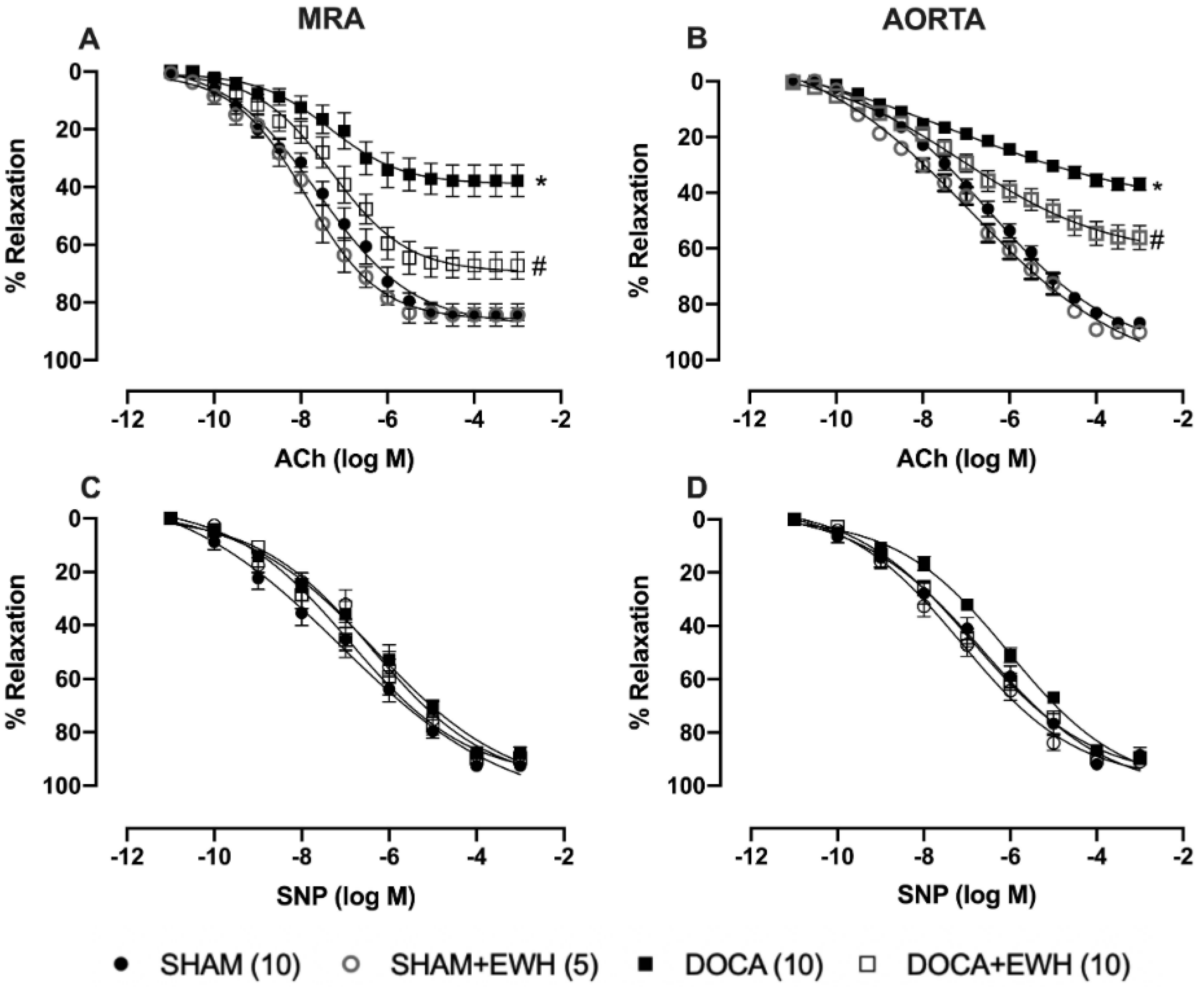
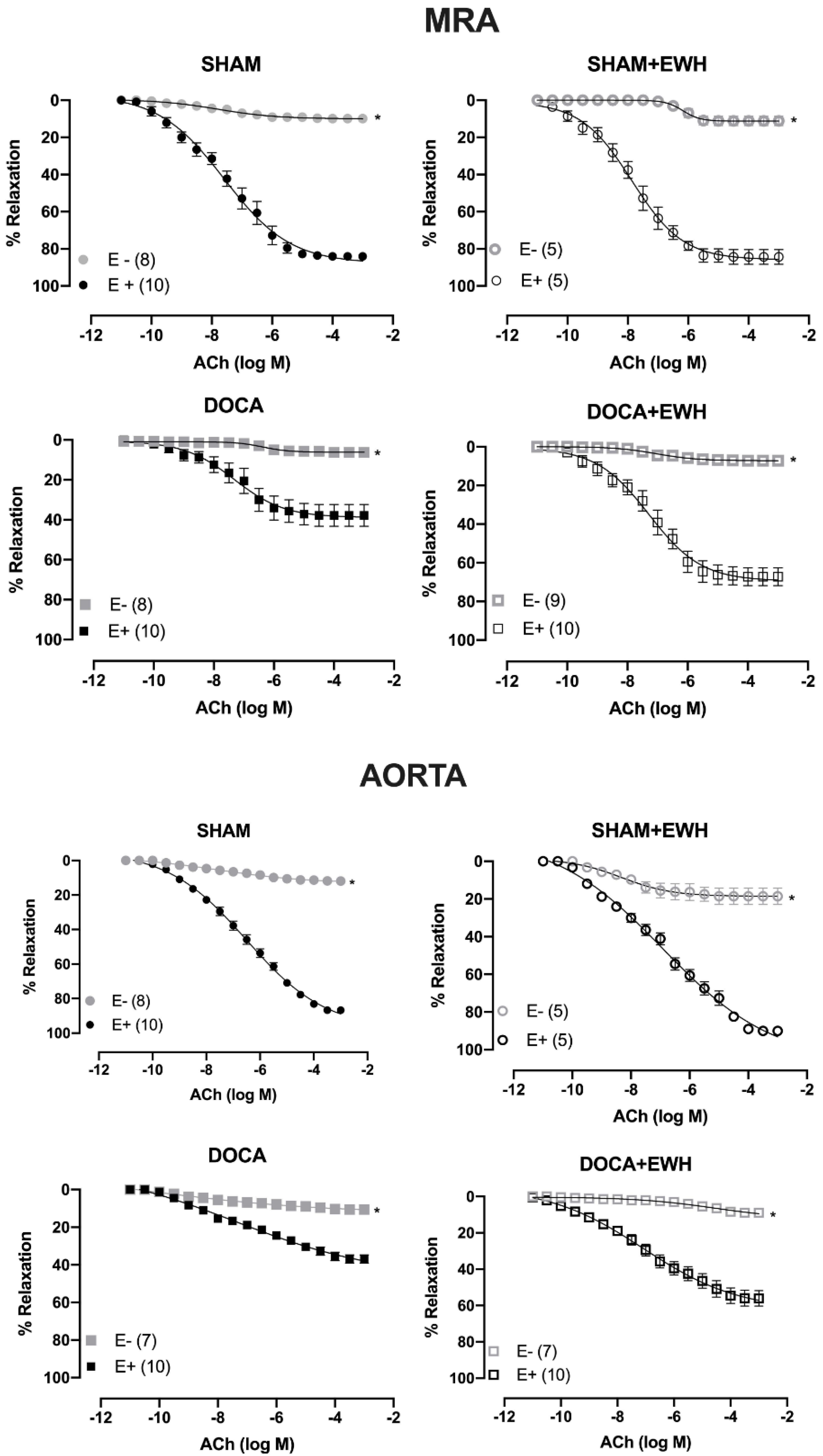
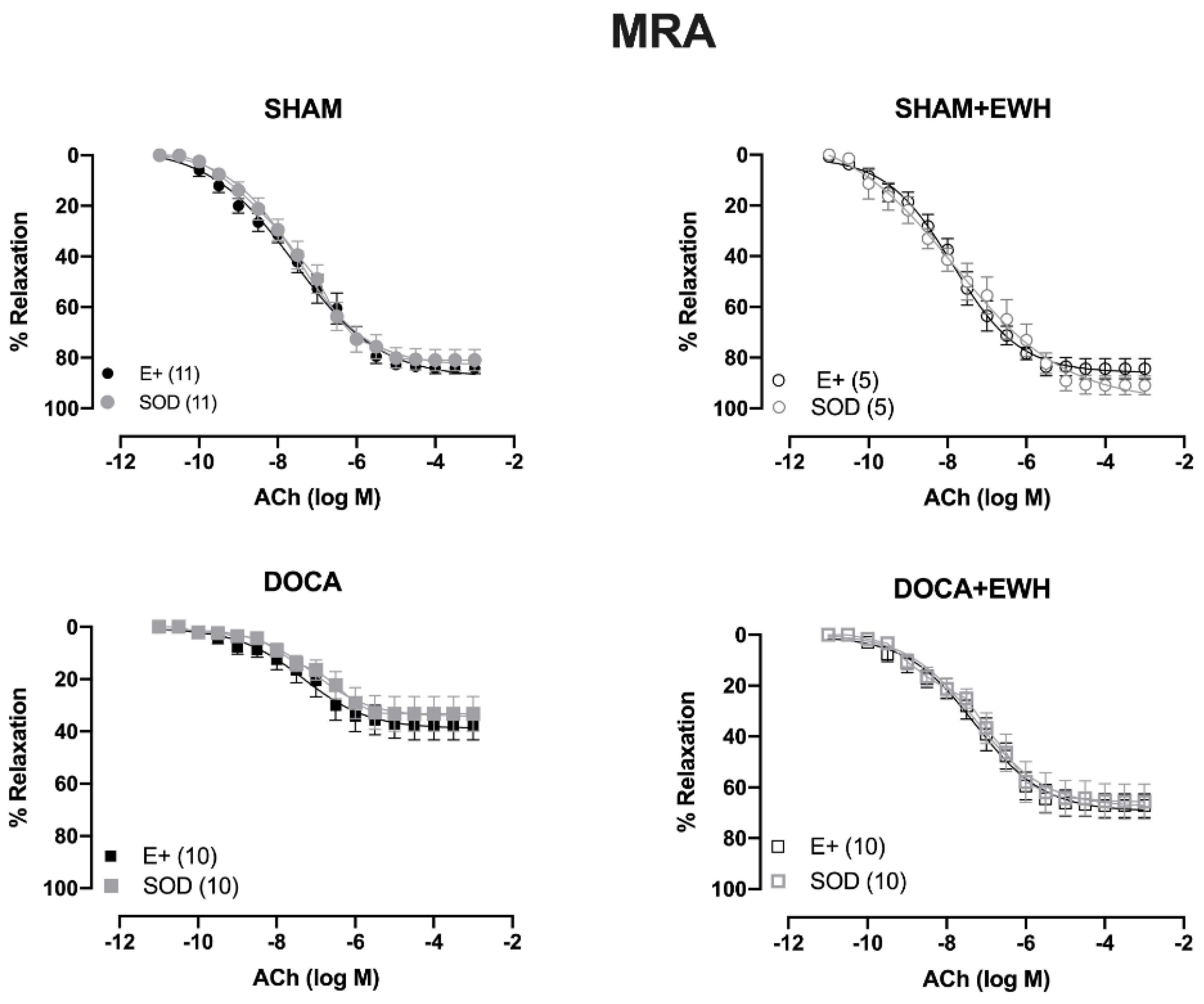

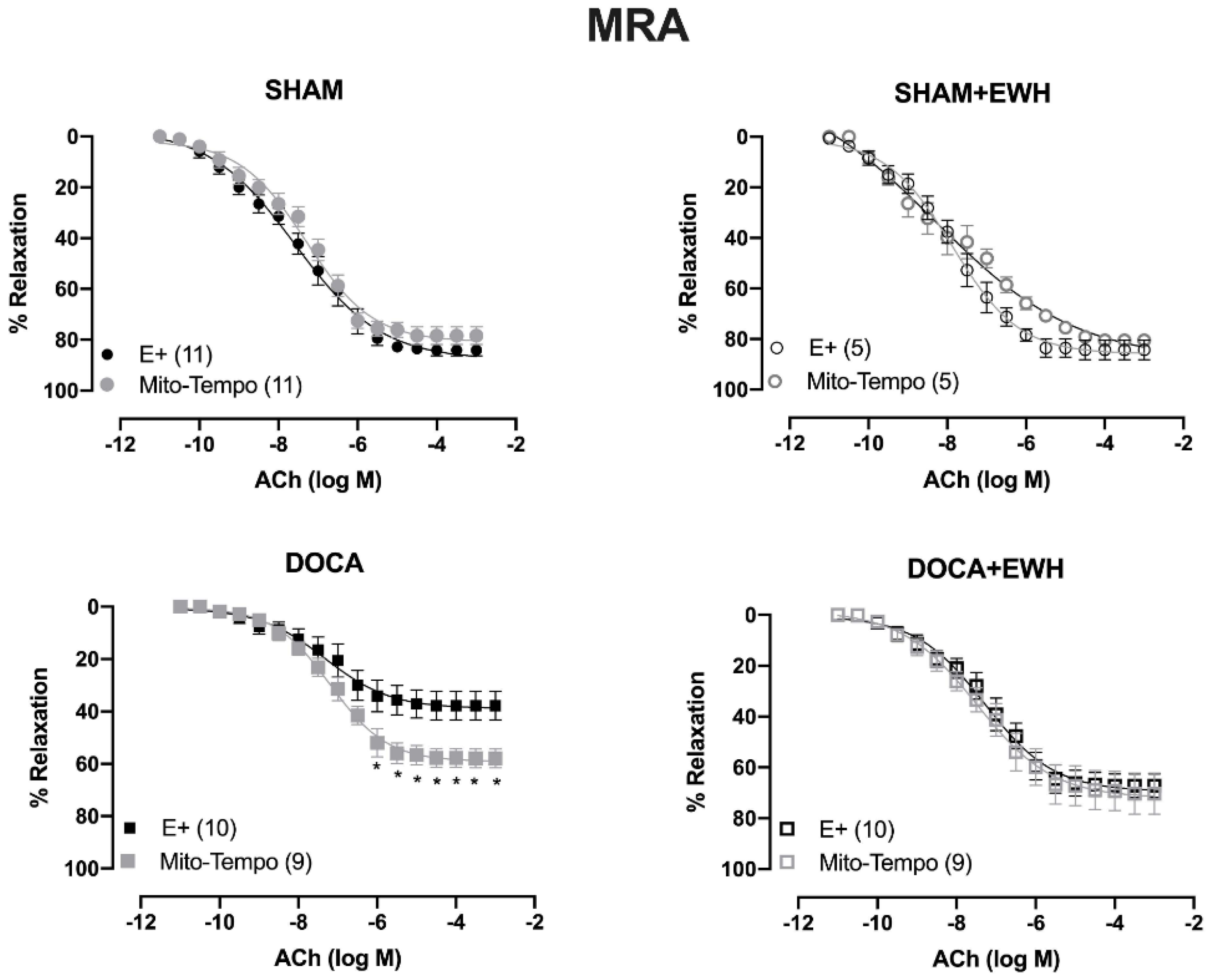
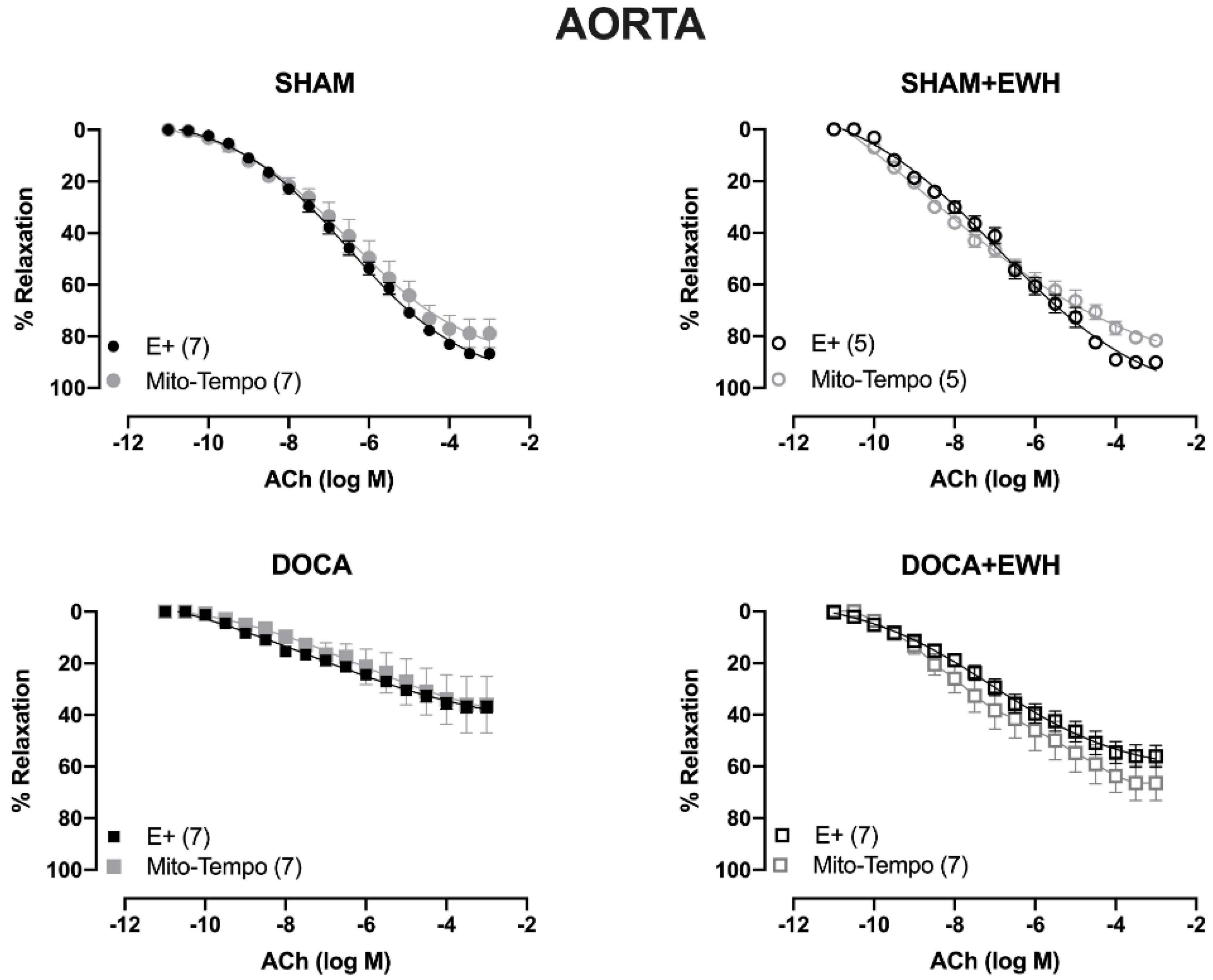
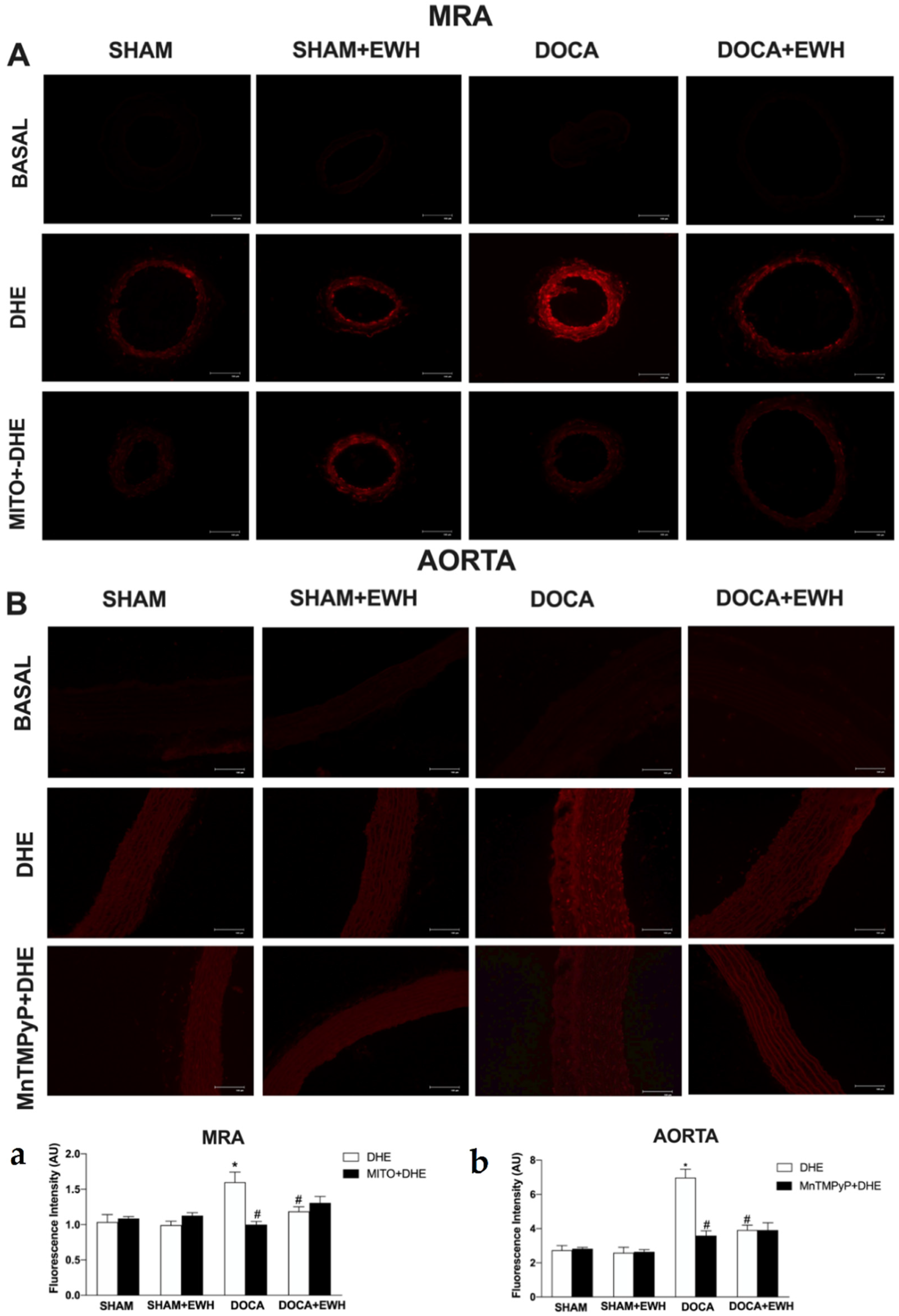
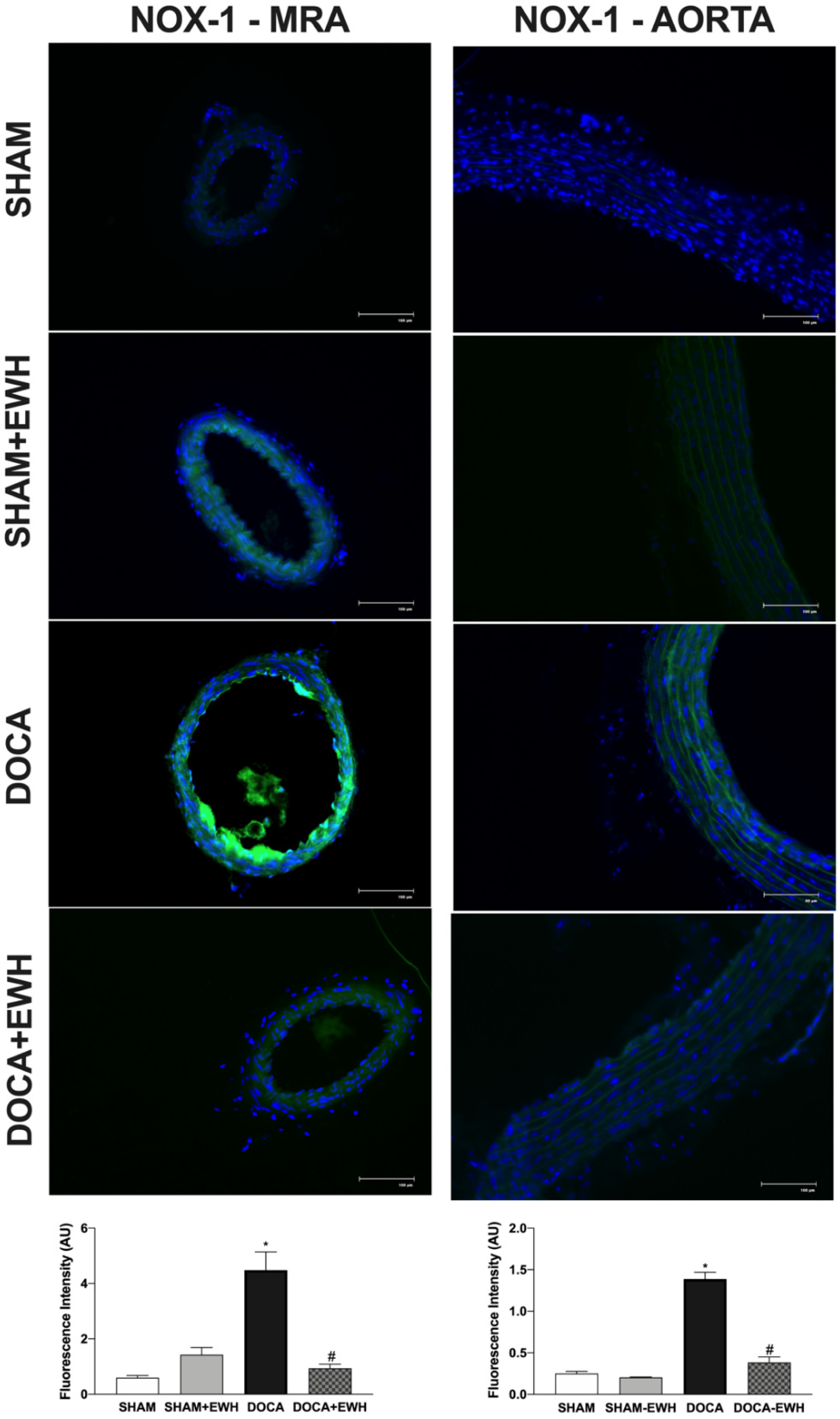


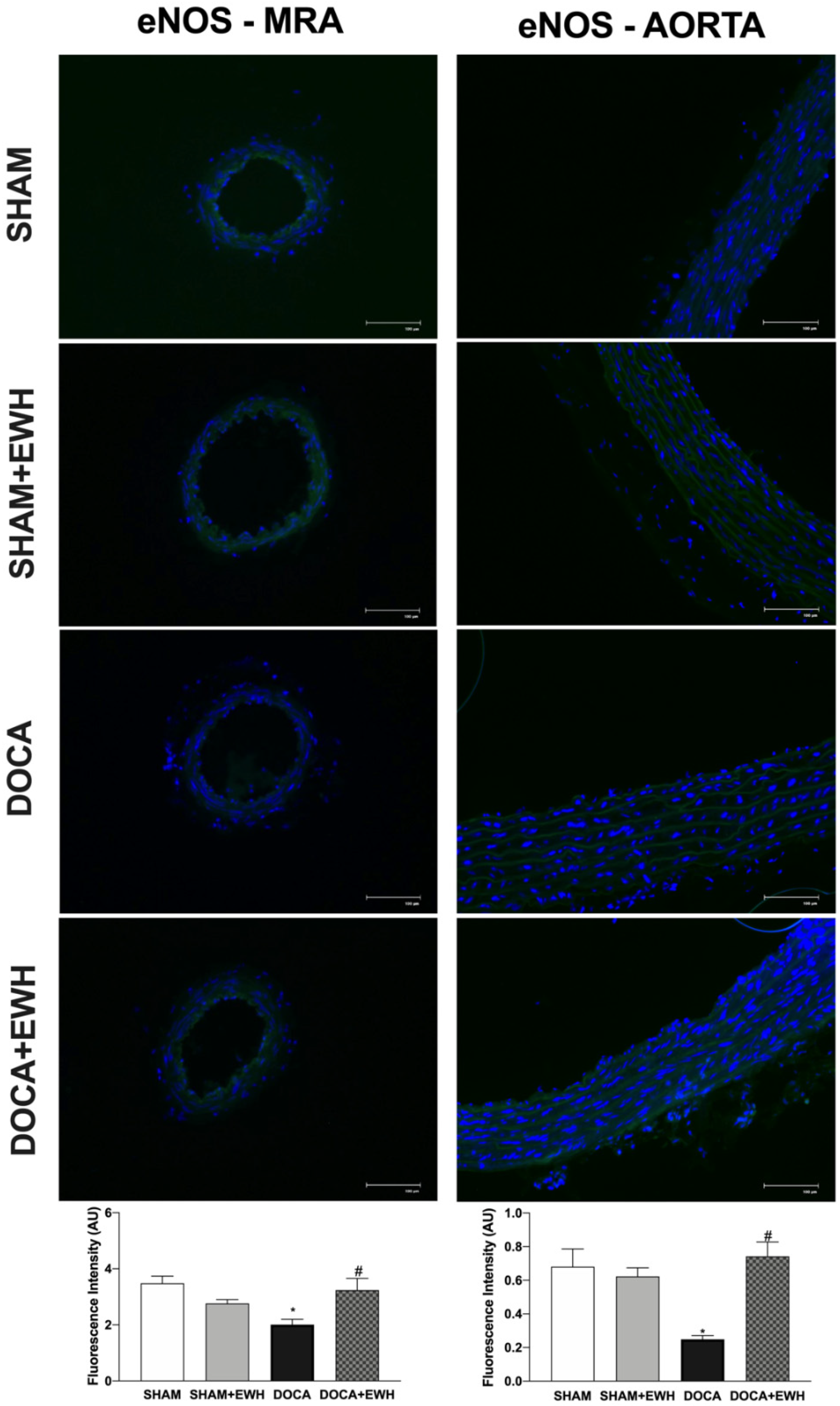
Publisher’s Note: MDPI stays neutral with regard to jurisdictional claims in published maps and institutional affiliations. |
© 2022 by the authors. Licensee MDPI, Basel, Switzerland. This article is an open access article distributed under the terms and conditions of the Creative Commons Attribution (CC BY) license (https://creativecommons.org/licenses/by/4.0/).
Share and Cite
Abreu, E.d.L.; Rodrigues Moro, C.; Hassan Husein Kanaan, S.; de Paula, R.B.; Herrera, C.T.; Costa, P.H.D.; Peçanha, F.M.; Vassallo, D.V.; Rossoni, L.V.; Miguel-Castro, M.; et al. ROS Suppression by Egg White Hydrolysate in DOCA-Salt Rats—An Alternative Tool against Vascular Dysfunction in Severe Hypertension. Antioxidants 2022, 11, 1713. https://doi.org/10.3390/antiox11091713
Abreu EdL, Rodrigues Moro C, Hassan Husein Kanaan S, de Paula RB, Herrera CT, Costa PHD, Peçanha FM, Vassallo DV, Rossoni LV, Miguel-Castro M, et al. ROS Suppression by Egg White Hydrolysate in DOCA-Salt Rats—An Alternative Tool against Vascular Dysfunction in Severe Hypertension. Antioxidants. 2022; 11(9):1713. https://doi.org/10.3390/antiox11091713
Chicago/Turabian StyleAbreu, Edina da Luz, Camila Rodrigues Moro, Samia Hassan Husein Kanaan, Ricardo Bernardino de Paula, Camila Teixeira Herrera, Pedro Henrique Dorneles Costa, Franck Maciel Peçanha, Dalton Valentim Vassallo, Luciana Venturini Rossoni, Marta Miguel-Castro, and et al. 2022. "ROS Suppression by Egg White Hydrolysate in DOCA-Salt Rats—An Alternative Tool against Vascular Dysfunction in Severe Hypertension" Antioxidants 11, no. 9: 1713. https://doi.org/10.3390/antiox11091713
APA StyleAbreu, E. d. L., Rodrigues Moro, C., Hassan Husein Kanaan, S., de Paula, R. B., Herrera, C. T., Costa, P. H. D., Peçanha, F. M., Vassallo, D. V., Rossoni, L. V., Miguel-Castro, M., & Wiggers, G. A. (2022). ROS Suppression by Egg White Hydrolysate in DOCA-Salt Rats—An Alternative Tool against Vascular Dysfunction in Severe Hypertension. Antioxidants, 11(9), 1713. https://doi.org/10.3390/antiox11091713







